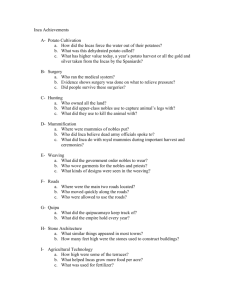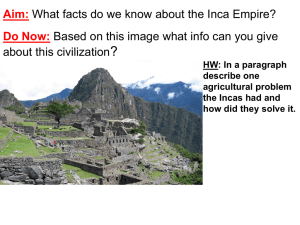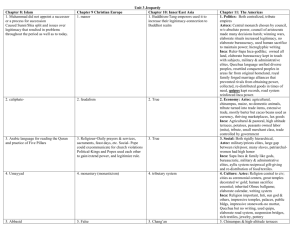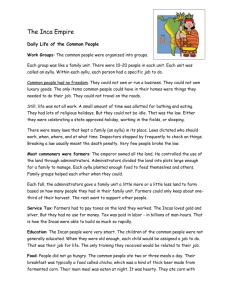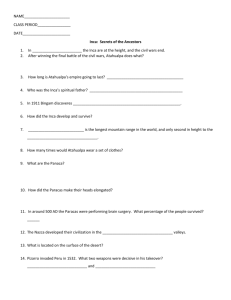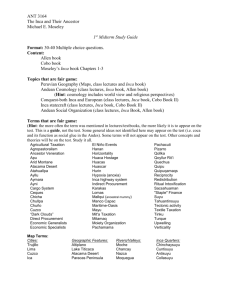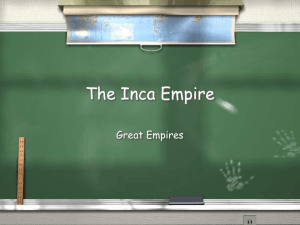Inca Trade
advertisement
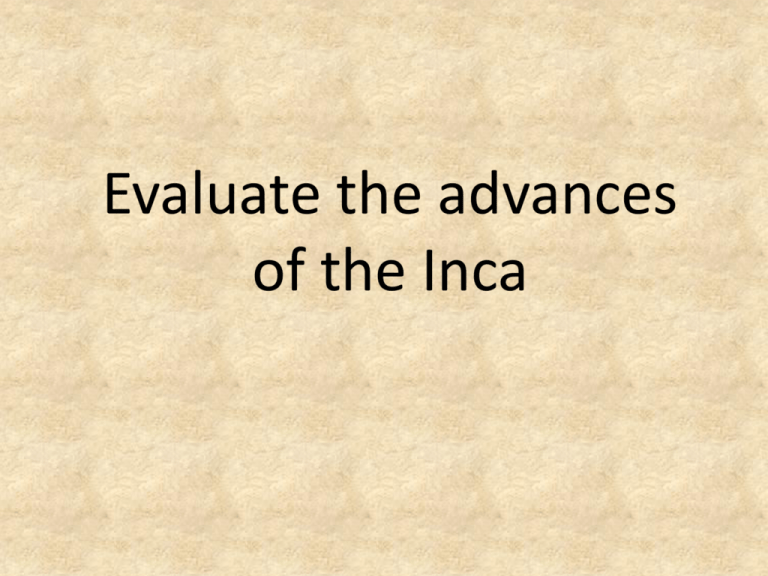
Evaluate the advances of the Inca Postclassical Advances Inca – Political The Incas ruled as a military and administrative elite. They led armies composed mostly of conquered peoples, and they staffed the bureaucracy that managed the empire's political affairs. But the Incas were not numerous enough to overwhelm their subjects. They routinely sought to encourage obedience among subject peoples by taking hostages from their ruling classes and forcing them to live at the Inca capital. When conquered peoples became restive or uncooperative, the Incas sent loyal subjects as colonists, provided them with choice land and economic benefits, and established them in garrisons to maintain order. When conquered peoples rebelled, Inca armies forced them to leave their homes and resettle in distant parts of the empire. The vast Inca realm presented a serious administrative challenge to its rulers. The Inca administrative system was the invention of Pachacuti, who implemented taxes to support Inca rulers & administrators, and organized a system of state-owned storehouses to stock agricultural surpluses and craft products such as textiles. He also began construction on an extensive network of roads that enabled Inca military forces and administrators to travel quickly to all parts of the empire. Inca – Economic Inca Trade Inca society did not generate large classes of merchants and skilled artisans. On the local level the Incas and their subjects bartered surplus agricultural production and handcrafted goods among themselves. Long-distance trade, however, fell under the supervision of the central government. Administrators organized exchanges of agricultural products, textiles, pottery, jewelry, and craft goods, but the Inca state did not permit individuals to become independent merchants. In the absence of a market economy, there was no opportunity for a large class of professional, skilled artisans to emerge. Many individuals produced pottery, textiles, and tools for local consumption, and a few produced especially fine goods for the ruling, priestly, and aristocratic classes. Inca Agriculture The cultivators were mostly peasants of common birth who lived in communities known as ayllu, which were the basic units of rural society. Ranging in size from small villages to larger towns, ayllusconsisted of several families who lived together, sharing land, tools, animals, crops, and work. Peasants supported themselves by working on lands allocated to individual families by their ayllu. Instead of paying taxes or tribute, peasants also worked on state lands administered by aristocrats. Much of the production from these state lands went to support the ruling, aristocratic, and priestly classes. The rest went into state storehouses for public relief in times of famine and for the support of widows, orphans, and others unable to cultivate land for themselves. Apart from agricultural work, peasants also owed compulsory labor services to the Inca state. Men provided the heavy labor required for the construction, maintenance, and repair of roads, buildings, and irrigation systems. With the aid of quipu, Inca bureaucrats kept track of the labor service and tribute owed by local communities. Inca – Religious The Incas considered their chief ruler a deity descended from the sun. In theory, this god-king owned all land, livestock, and property in the Inca realm, which he governed as an absolute and infallible ruler. Inca rulers retained their prestige even after death. Their descendants mummified the royal remains and regarded departed kings as intermediaries with the gods. Succeeding rulers often deliberated state policy in the presence of royal mummies so as to benefit from their counsel. Indeed, on the occasion of certain festivals, rulers brought out the mummified remains of their ancestors, dressed them in fine clothes, adorned them with gold and silver jewelry, honored them, and presented them with offerings of food and drink to maintain cordial relations with former rulers. Members of the Inca ruling class venerated the sun as a god and as their major deity, whom they called Inti. They also recognized the moon, stars, planets, rain, and other natural forces as divine. Some Incas also showed special favor to the god Viracocha, creator of the world, humankind, and all else in the universe. The cult of the sun, however, outshone all the others. In Cuzco alone some four thousand priests, attendants, and virgin devotees served Inti, whose temple attracted pilgrims from all parts of the Inca empire. The first Spanish visitors to Cuzco reported that it took four hundred paces for them to walk around the temple complex, and they expressed amazement at its lavish decoration, including a golden sculpture of the sun encrusted with gems. Particularly astonishing to the visitors was an imitation garden in which grains of gold represented a field, which was planted with stalks of maize fabricated from gold and surrounded by twenty golden llamas with their attendants, also sculpted in gold. Priests of Inti and those serving other cults honored their deities with sacrifices, which in Inca society usually took the form of agricultural produce or animals such as llamas and guinea pigs rather than humans. The Incas taught a concept of sin as a violation of the established social or natural order, and they believed in a life beyond death, during which individuals would receive rewards or punishments based on the quality of their earthly lives. The Incas also observed rituals of confession and penance by which priests absolved individuals of their sins and returned them to the good graces of the gods. Inca – Social The main classes in Inca society were the rulers, the aristocrats, the priests, and the peasant cultivators of common birth. The Inca god-kings supervised a class of bureaucrats, mostly aristocrats, who allocated plots of land for commoners to cultivate on behalf of the state. Like the ruling elites, Inca aristocrats and priests led privileged lives. Aristocrats consumed fine foods and dressed in embroidered clothes provided by common subjects. Aristocrats also had the right to wear large ear spools that distended their lobes so much that Spanish conquerors referred to them as “big ears.” Priests often came from royal and aristocratic families. They led celibate and ascetic lives, but they deeply influenced Inca society because of their education and their responsibility for overseeing religious rituals. The major temples supported hundreds of priests, along with attendants and virgin women devoted to divine service who prepared ceremonial meals and wove fine ritual garments for the priestly staff. Inca – Intellectual At the center of Cuzco was a huge plaza filled with glistening white sand transported from Pacific beaches to the high Andean city. Surrounding the plaza were handsome buildings constructed of red stone cut so precisely by expert masons that no mortar was necessary to hold them together. The most important buildings sported gold facings, which threw off dazzling reflections when rays of the Andean sun fell on them. Since Cuzco was primarily a capital and a ceremonial center, the city's permanent population was sizable but not enormous—perhaps forty thousand—but some two hundred thousand Inca subjects lived in the immediate vicinity. In the absence of any script or system of writing, Inca bureaucrats and administrators relied on a mnemonic aid known as quipu to keep track of their responsibilities. Quipu consisted of an array of small cords of various colors and lengths, all suspended from one large, thick cord. Experts tied a series of knots in the small cords, which sometimes numbered a hundred or more, to help them remember certain kinds of information. Most quipu recorded statistical information having to do with population, state property, taxes, and labor services that communities owed to the central government. Occasionally, though, quipu also helped experts to remember historical information having to do with the establishment of the Inca empire, the Inca rulers, and their deeds. Inca – Intellectual In the case of the Peruvian bridges, the builders relied on a technology well suited to the problem and their resources. The Spanish themselves demonstrated how appropriate the Peruvian technique was. Dr. Ochsendorf, a specialist in early architecture and engineering, said the colonial government tried many times to erect European arch bridges across the canyons, and each attempt ended in fiasco until iron and steel were applied to bridge building. The Peruvians, knowing nothing of the arch or iron metallurgy, instead relied on what they knew best, fibers from cotton, grasses and saplings, and llama and alpaca wool. The Inca suspension bridges achieved clear spans of at least 150 feet, probably much greater. This was a longer span than any European masonry bridges at the time. The longest Roman bridge in Spain had a maximum span between supports of 95 feet. And none of these European bridges had to stretch across deep canyons. Garcilasco de la Vega, in 1604, reported on the cable-making techniques. The fibers, he wrote, were braided into ropes of the length necessary for the bridge. Three of these ropes were woven together to make a larger rope, and three of them were again braided to make a still larger rope, and so on. The thick cables were pulled across the river with small ropes and attached to stone abutments on each side. Three of the big cables served as the floor of the bridge, which often was at least four to five feet wide, and two others served as handrails. Pieces of wood were tied to the cable floor. Finally, the floor was strewn with branches to give firm footing for beasts of burden. More branches and pieces of wood were strung to make walls along the entire length of the bridge. The side covering, one chronicler said, was such that “if a horse fell on all fours, it could not fall off the bridge.” - John Noble Wilford, The New York Times 2007 Inca – Artisic Inca art took the forms of pottery, metallurgy, jewelry, weaving, and music. Women delivered tribute in the form of textiles, pottery, and jewelry. The Incas had two types of musical instruments, wind and percussion. String musical instruments were introduced by the Spanish and adapted to their music repertoire. Music reached all corners of the empire and all social classes. The Incas used one word “taqui” to describe dance, music and singing, though this word in Quechua means “song”. Their music was pentatonic; they based their music in the combination of five notes re, fa, sol, la and do. Most of the Inca gold jewelry and artifacts was looted by the Spanish conquerors, melted and taken away to Spain. The largest part of the pieces shown in museums have been found by archeologist in burial grounds. They show us to a great extent the meaning and use of jewelry in the Inca civilization. The pottery created by the Inca civilization was of a superb standard in particular the quality of the glazing used in Inca pottery. The majority of Inca designs were similar to that of what had been created by previous generations often following a similar design with little variety, however the technique used to create the pottery was much more advanced than that of its predecessors. One of the most common items created in the pottery industry of the Inca people was the aryballus. This was a large jar that had a round base moving into a cone shape with a wide neck, often used to store liquids. Inca – Near (Geography) The Incas built around 12, 500 miles of road. The two main royal roads ran parallel to each other; one ran through the Andes and the other ran along the coast. Distance markers were placed along the roads called topo. In difficult terrain, such as mountainous areas, the roads were stepped or zig-zagged. This shows the capability of Inca engineering. Streams were crossed by wooden or stone bridges. Mountains and rivers were crossed by reed-plaited suspension bridges. -Leicester University Inca roads were among the best ever constructed before modern times. During the early sixteenth century, Spanish conquerors marveled at the roads—paved with stone, shaded by trees, and wide enough to accommodate eight horsemen riding abreast. A corps of official runners carried messages along the roads so that news and information could travel between Cuzco and the most distant parts of the empire within a few days. Machu Pichu Inca Aztec Inca Video

